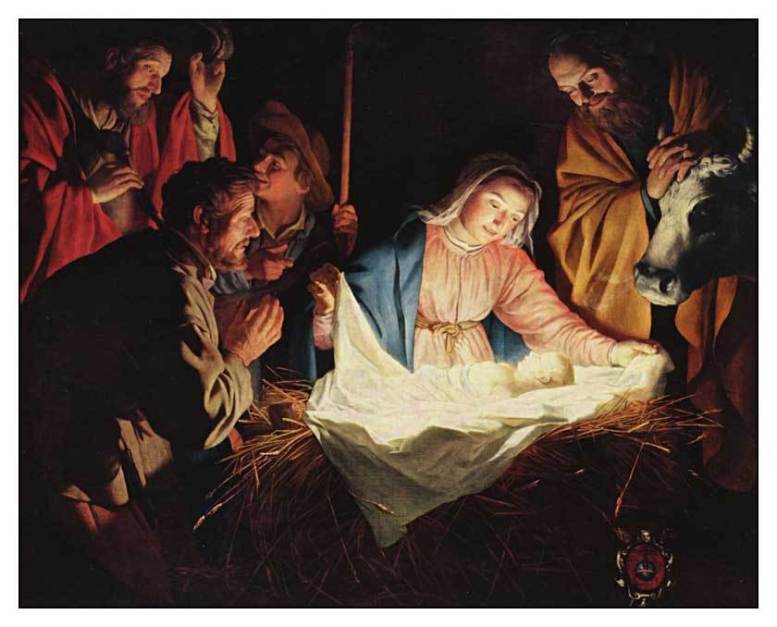Would the Mother of God Ever Wear Jeans?
Would the Mother of God Ever Wear Jeans?

 I’ve written before about the first time I went Christmas shopping alone with my mom. It was in 1969, when I was 12 years old. At that time, my parents had 13 children — seven boys and six girls — all of whom were living at home.
I’ve written before about the first time I went Christmas shopping alone with my mom. It was in 1969, when I was 12 years old. At that time, my parents had 13 children — seven boys and six girls — all of whom were living at home.
One of the things I remember about that trip was the huge buildings downtown, all of which had big, heavy entrance doors. I remember the entrance doors because it was on that trip that my mom taught me what I had to do if I was ever going to become a real “gentleman.”
When I walked into the first store ahead of my mom, she stopped me and told me that a gentleman always opened the door for a woman, so the woman could enter first. So there I was, 12 years old, struggling to maneuver the heavy doors on the huge buildings so my mom could walk into the stores ahead of me.
Mom also taught me that whenever I was walking with a woman on a sidewalk that bordered a street, as a gentleman, I was expected to walk on the curbside of the sidewalk (between the woman and the cars that were driving by). Her explanation for this was that it was s man’s duty to act as a buffer between the traffic and the woman he was with, which protected the woman from being splashed by cars driving through puddles, and from being hit by any cars that might jump the curb and come onto the sidewalk.
In addition to opening doors and protecting a woman based on where I was walking, Mom insisted that I treat her and my sisters with a higher level of respect than what was expected of me when I was dealing with my brothers. She taught me that I had an obligation to behave differently toward women than I behaved toward my brothers. She also taught my sisters that if they expected to be treated with respect, they had to behave in such a way that they telegraphed to men that they deserved their respect.
All this took place during the 1960s and 1970s when women in our society were demanding that they be liberated from having to dress and behave in the same way that their mothers and grandmothers had behaved. During that time, my mom fought to hold onto the standards of behavior that had been followed by women for centuries.
It was during that period of time that women began wearing bikinis, miniskirts, hot pants, and halter tops. My mom hated the new fashions and demanded that her daughters dress modestly.
Another shift that took place during those years was that woman started wearing jeans in public. Wikipedia provides the following brief history of jeans:
Often the term “jeans” refers to a particular style of pants, called “blue jeans,” which were invented by Jacob Davis in partnership with Levi Strauss & Co in 1871, and patented by Jacob Davis and Levi Strauss on May 20, 1873. Prior to the Levi Strauss patented trousers, the term “blue jeans” had been long in use for various garments (including trousers, overalls, and coats), constructed from blue colored denim. Originally designed for cowboys and miners, jeans became popular in the 1950s among teenagers, especially members of the greaser subculture. Jeans were a common fashion item in the 1960s hippie subculture and they continued to be popular in the 1970s and 1980s youth subcultures of punk rock and heavy metal.
Prior to the 1960s, women were rarely seen in public wearing jeans. Until that time, among Christians, it was considered sinful for women to wear jeans in public. The wearing of jeans by women gave them the freedom to sit in public with their legs spread apart. Prior to that time, women were taught that sitting with their legs spread apart was immodest and highly inappropriate. Women who wore skirts and dresses never sat with their legs spread apart, but instead, always sat with their knees together and their legs positioned in such a way that certain parts of their body were hidden from view.
Now, of course, women have graduated to the tight, form-fitting leggings that reveal more of their bodies than was ever revealed by jeans. With leggings, there’s not much left to the imagination. My mom would have (justifiably) freaked out if my sisters had ever come home wearing leggings.
By providing a brief history of women and jeans, I’m not passing judgment or condemning any woman who wears jeans today. I’m simply offering an explanation as to what the beliefs and behavior of women were prior to being “liberated” from the constraints that had been placed upon them by their parents, culture, and religion.
In my mom’s quest to teach my sisters about the appropriate way to dress, she frequently told them that the only acceptable standard for the way a woman should dress was set by the Blessed Virgin Mary. Mom emphasized that if my sisters expected men to respect them, they had to first dress and behave in a way that showed that they respected themselves. She told them that they would never go wrong if they wore clothing that would meet with the approval of the Blessed Mother.
I expect that there were many women in my mom’s generation who attempted to teach their daughters the same lessons. Unfortunately, we don’t hear much about modesty anymore.
There’s a shocking difference between the behavior and values of a majority of people today compared with what was acceptable behavior prior to the 1960s. In addition to the breakdown of modesty among women, there has been a drastic deterioration in the distinction between genders. It’s common now to see women dress, walk, and talk like men. We currently have government agencies and schools that are insisting that boys who think they’re girls should be allowed to use the girls’ restrooms, and girls who think they’re boys should be allowed to use the boys’ restrooms.
The breakdown in the distinction between genders has directly coincided with the deterioration of our Christian culture and the abandonment of modesty by women. Until the 1960s, when our values were still based primarily on Christian principles, the majority of women cared deeply about the way they dressed, walked, talked, and behaved when they were in the presence of men. Catholic girls were taught that there was great dignity in being a woman and that if they wished to reach perfection, they should emulate the most perfect woman who was ever created, the Mother of God.
Today, there are numerous Catholics who believe that devotion to the Mother of God somehow deprives Jesus of the honor and respect He is entitled to receive. What these people fail to realize is that every prayer that is said to Mary is purified, enhanced, and magnified by her before it is presented by her to the King of Heaven.
During the time that Mary was pregnant with Jesus, she went to assist her elderly cousin Elizabeth who was pregnant with Saint John the Baptist. As soon as Elizabeth saw Mary, she proclaimed, “Blessed art thou among women and blessed is the fruit of thy womb.” Mary reactively responded with a statement that we now know as “The Magnificat,” which begins with, “My soul proclaims the greatness of the Lord, my spirit exalts in God my Savior.” As soon as Mary was praised by her cousin, she immediately and reactively praised God and gave all the glory to Him. She does the same thing every time we pray to her.
During this Christmas season, I want you to give some thought to the fact that Jesus was a mirror image of Mary. Because she was his virginal mother, all of His human characteristics were inherited from her. He had no biological father so the color of His eyes, the tone of His skin, and the structure and features of His face were all inherited from His mother.
Food for thought while you contemplate the teenage girl, her older husband, and the birth of our Savior on that cold night in December more than 2,000 years ago.
Merry Christmas!



1 Comment
Dear Georgette and Harry –
Your presentation this week is very timely! I’ve been thinking of Mary’s pregnancy during these last days of waiting for the birth of her SON, who is to be named Jesus. Did she experience pain, as we know most pregnant women feel? Riding a donkey must have been uncomfortable, and for such a long time! Joseph and Mary both must have suffered mentally as well as physically throughout their “wait”.
So, along with the joy, the knowledge of WHO was to be born, the anticipation far overshadowed the pain. These thoughts are with me as Christmas approaches! May your Christmas be filed with delight and wonder that the Christ Child brings. Love, Sister Roberta